Exploring the Appeal of Maple Kitchen Wall Cabinets
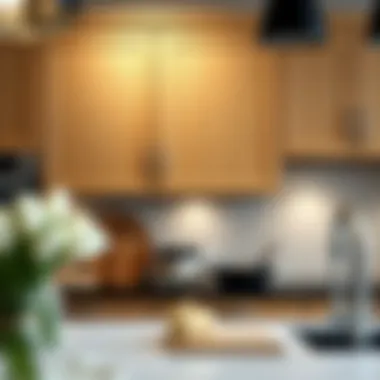
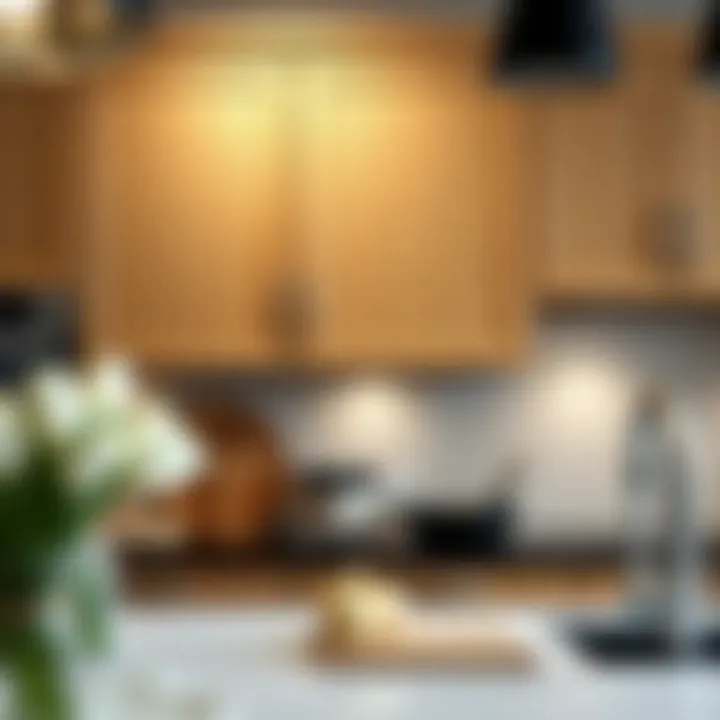
Intro
When it comes to creating a kitchen that blends both style and function, maple kitchen wall cabinets stand out as a prominent choice. These cabinets are not only visually appealing but also offer practical solutions for storage, making them a favorite among homeowners and designers alike. Maple wood, known for its durability and fine grain, has a well-regarded reputation in cabinetry, allowing for a variety of finishes and styles that can fit any kitchen design.
This article will provide a thorough exploration of maple kitchen wall cabinets. We’ll delve into trends currently shaping furniture design, practical tips for selecting the right cabinets, and considerations for maintenance. By understanding the unique characteristics of maple and how it integrates into various kitchen styles, readers will be equipped to make informed decisions that enhance their living spaces.
Furniture Design Trends
Exploring current furniture design trends gives insight into how maple cabinets can adapt to contemporary tastes. Knowing what materials and styles resonate with homeowners is crucial for making the right selections.
Trending Materials and Textures
In today’s market, there’s a great emphasis on using natural materials, and maple fits that bill well. With its smooth surface and subtle grain patterns, it presents a warmth that many engineered materials lack. The texture of polished maple can create a sophisticated look, while unfinished or reclaimed options bring an element of rustic charm. It's not uncommon to see blends of maple with metals or glass for a modern touch, bringing a striking balance between traditional and cutting-edge designs.
Color Palettes and Styles
Maple kitchen cabinets can be finished in an array of colors, ranging from natural light hues to deep, rich stains. Lighter shades of maple, like honey or cream, can open up smaller kitchens, creating an airy feel. Conversely, darker tones can add depth and elegance, particularly suited for contemporary or industrial designs. The transition in color serves more than just aesthetics; it can influence the mood of the space.
"Choosing the right color palette is as important as selecting the right material. It defines the ambiance you will experience in your kitchen."
Practical Tips for Furniture Selection
Selecting the right cabinets goes beyond mere aesthetics. Functionality plays an equally significant role. Here are some pointers to consider.
Assessing Space and Functionality
Before delving into design choices, take a close look at your kitchen layout. Measure the area where the cabinets will be installed to ensure a good fit and ample storage. Maple cabinets, with their robustness, can be used for various configurations like overhead cabinets or corner units, maximizing space. It’s also wise to think about what you’ll store within those cabinets—plates, pots, or pantry items—and how often these items will be accessed.
Balancing Aesthetics with Comfort
While visual appeal is crucial, the comfort and ease of use shouldn’t be overlooked. Look for features like soft-close hinges and ergonomic designs that ensure functionality. It’s also helpful to visualize how different finishes will look with your countertops and flooring to maintain cohesion throughout your kitchen design. Remember that the kitchen is where you gather, cook, and entertain; comfort and style should go hand in hand.
By examining these trends and selecting based on practical tips, homeowners and designers alike can make informed choices about incorporating maple kitchen wall cabinets into their spaces.
Prologue to Maple Kitchen Wall Cabinets
When it comes to kitchen design, maple kitchen wall cabinets stand out for their blend of durability and aesthetic charm. These cabinets are more than just storage; they embody the spirit of the kitchen, often becoming the focal point of the entire space. Their construction not only caters to functionality but also plays a crucial role in setting the atmosphere and ambiance of the kitchen. A well-designed kitchen can improve overall comfort and style, making the choice of cabinetry an essential consideration.
In this article, we will explore various aspects of maple kitchen wall cabinets, ranging from their defining characteristics to their practical benefits and compatibility with different design styles. Homeowners, designers, and decorators alike will find valuable insights aimed at elevating their understanding and appreciation of maple cabinets.
Defining Maple Kitchen Cabinets
Maple kitchen cabinets are constructed from maple wood, a hardwood known for its strength and fine grain. The use of this wood offers a variety of finishing options, which allows homeowners to tailor the appearance of the cabinets to fit their personal style and kitchen décor. Maple is often categorized by its light color, which can range from creamy white to a subtle yellow hue. The wood’s fine grain provides an attractive surface that can be enhanced through staining or left natural.
The construction process of maple cabinets can incorporate various techniques, from traditional dovetail joints to modern soft-closing hinges. This adds to the durability and functionality of the cabinets.
Why Choose Maple?
Opting for maple wood for kitchen cabinets carries several benefits. To put it simply, maple is like the Swiss Army knife of cabinetry materials. Here are a few compelling reasons:
- Durability: Maple is robust and resistant to wear, making it ideal for high-traffic kitchens.
- Versatility: Its neutral coloring complements a wide range of interior styles, from contemporary to classic.
- Cost-Effectiveness: Compared to other hardwoods, maple usually offers a good balance between quality and price.
- Sustainability: Often sourced from sustainably managed forests, maple wood presents an eco-friendly choice for conscientious consumers.
Choosing maple kitchen wall cabinets can enhance both the form and function of your kitchen, making them a worthy consideration whether you're remodeling or building from scratch.
Characteristics of Maple Wood
When it comes to kitchen cabinetry, the characteristics of the wood chosen can greatly influence both the longevity and aesthetics of the space. Maple wood is often celebrated in the realm of cabinetry for its unique attributes. Understanding these characteristics not only helps in making an informed choice but also connects the style of your kitchen with practical needs. We will explore the durability and aesthetic appeal of maple wood, focusing on how these traits serve the interests of homeowners and designers alike.
Durability and Strength
Maple wood is known for its outstanding durability and robust structure. This hardwood can withstand significant wear and tear, making it a sensible choice for wall cabinets that often bear heavy loads, such as dishes and appliances. Its resistance to dents, scratches, and warping ensures that cabinets maintain their form and function over time. This strength is not just about the wood’s physical attributes; it also represents a good investment. When choosing cabinetry, opting for maple wood can mean fewer repairs and replacements further down the line, ultimately offering value for money.
Aesthetic Qualities
The aesthetic qualities of maple wood play an equally vital role in its appeal for kitchen cabinetry. It brings a warm, inviting feel to the kitchen space, thanks to its natural beauty. The allure lies in the grain patterns and color variations inherent to the wood, which can complement various design styles.

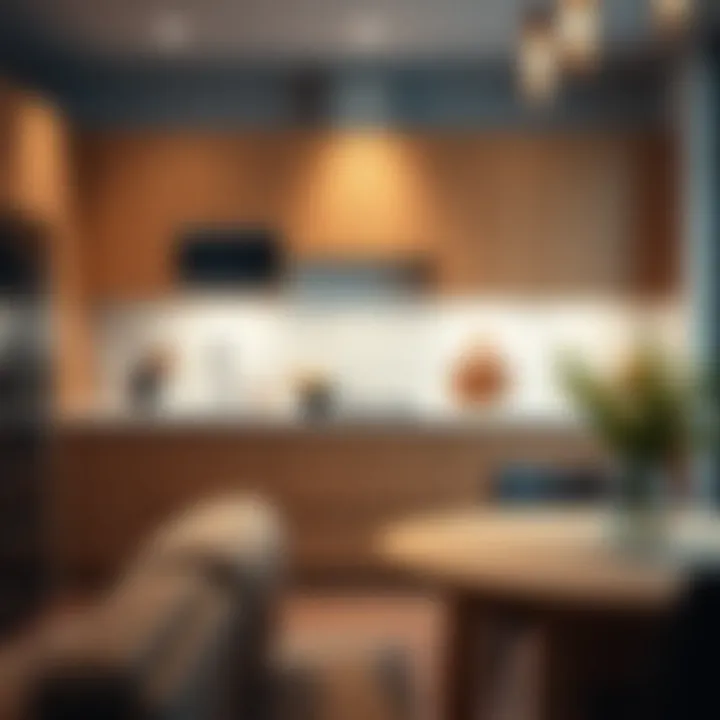
Natural Grain Patterns
The natural grain patterns of maple wood are one of its standout features. These patterns are not overly pronounced but are nonetheless distinct enough to add depth and character to cabinetry. The subtle swirls and streaks contribute to the wood’s visual interest, providing a beautiful backdrop for any kitchen decor.
A key characteristic of these patterns is their versatility. Natural grains blend well with both traditional and contemporary design styles, making maple cabinets a popular choice. Such adaptability is often deemed beneficial by homeowners looking to future-proof their kitchens. For instance, if a homeowner decides to refresh their kitchen decor, the understated elegance of maple will likely harmonize without needing a complete rollback.
However, potential disadvantages might include that some homeowners prefer more pronounced grain patterns found in other woods, which can lead to a more rustic appearance. Yet, for those inclined toward a simpler aesthetic, the subdued grain of maple is a significant advantage.
Color Variations
Color variations in maple wood also play a crucial role. Typically, the wood ranges from a light cream to a pale yellow, sometimes taking on a reddish hue depending on the specific type of maple and finish. This variation can beautifully warm up a kitchen space, enhancing the overall ambiance.
The key advantage of these color variations is their compatibility with various color schemes. Homeowners can easily match the cabinetry with countertops, backsplashes, and flooring, thus creating a cohesive appearance. Unlike darker woods that can dominate a space, the lighter tones of maple can make a kitchen look larger and brighter.
Nevertheless, some might argue that the lighter colors could show dirt or wear more readily than darker choices. Regular maintenance can mitigate this concern, ensuring the cabinets look fresh and clean.
"Maple wood balances durability with aesthetic charm, making it a prime contender for kitchen cabinetry."
Design Styles for Maple Kitchen Cabinets
When it comes to kitchen design, maple cabinets can be a game changer, bringing in various styles that resonate with personal tastes and home themes. The design styles adopted for maple cabinets significantly influence the kitchen's atmosphere, functionality, and overall aesthetic. Homeowners and designers alike find the versatility of maple facilitates multiple stylistic approaches, be it traditional, modern, or farmhouse. Each style not only enhances the beauty of the kitchen but also complements its function, making the space both welcoming and practical.
Traditional Designs
Traditional designs evoke a sense of timelessness and warmth, making them a popular choice among homeowners looking to retain a classic feel. Maple wood's rich grain complements intricate moldings and detailing typically associated with this style. Consider the ornate finishing touches such as raised panel doors, pilasters, and crown moldings which add character and elegance to the cabinetry.
In a traditional kitchen, the color palette often leans towards warmer tones, with shades of cream, honey, or even deep walnut maintaining a cozy ambiance. Stained finishes that highlight the wood's natural grain become essential here rather than painted surfaces.
"A traditional kitchen is about creating a space that feels like home; where the memories are made around the table, and the aroma of home-cooked meals fills the air."
This style does not just stop at aesthetics. Traditional maple cabinets are also quite functional, often incorporating open shelves or display cabinets to showcase dishware or decorative items. This careful design helps keep the kitchen organized while still letting it breathe visually.
Modern Aesthetics
As tastes evolve, so do kitchen designs, leading to the rise of modern aesthetics in maple cabinetry. A modern kitchen is characterized by clean lines, minimalistic design, and functional arrangements. Maple’s inherent lightness lends itself well to contemporary styles, especially when combined with sleek hardware and flat-front cabinetry.
Using neutral colors like whites, grays, or even black can create a sense of spaciousness while allowing the inherent beauty of maple to shine through. Integrating glass cabinets or open shelving can introduce layers and depth without overwhelming the overall look.
Additionally, modern designs often emphasize technology and smart storage solutions, making the kitchen highly functional. Pull-out drawers, soft-close hinges, and hidden compartments can provide seamless usability, complementing the modern aesthetic.
Farmhouse Inspirations
The farmhouse style, with its rustic charm, has gained tremendous popularity in recent years. Maple cabinets can embody this theme beautifully, providing warmth and character to the kitchen. This style typically employs a more rustic finish, which may include distressed surfaces or whitewashed tones, giving the cabinets a lived-in feel.
Farmhouse kitchens often incorporate accessories that evoke memories of simpler times, such as exposed beams, shiplap walls, and vintage hardware. Open shelving displaying handmade pottery or glass jars can break the monotony and offer a personal touch.
A hallmark of the farmhouse style is its focus on functionality as well as aesthetics. Maple's durability lends itself well to busy kitchens, allowing ample storage for both modern appliances and rustic kitchenware.
In summary, choosing the right design style for maple kitchen cabinets isn't just about looks; it's about creating a space that reflects personal taste while maximizing functionality. Through traditional elegance, modern simplicity, or rustic charm, maple can fulfill a diverse range of design aspirations, making it a premier choice for kitchen cabinetry.
Finishing Options for Maple Cabinets
The finishing choices for maple cabinets are not just about aesthetics; they play a crucial role in how these installations perform, behave over time, and look in your kitchen. When you select the right finish, you not only protect the wood but also enhance its natural beauty, amplifying the overall ambiance of your kitchen space. Proper finishing can help maintain the integrity of the cabinets, ensuring they withstand daily wear and tear while looking sharp.
Stains and Paints
Choosing between stains and paints can feel a bit like deciding whether to have cake or pie at dinner; both offer unique benefits. Staining maple cabinets can highlight the innate grain patterns, allowing the natural texture of the wood to shine through. Lighter stains can give a fresh and airy feel, while deeper colors can bring warmth and richness.
For instance, a walnut stain can create a stunning contrast against lighter countertops or backsplashes. Don’t overlook the potential of gel stains, which work wonders for maple due to their consistency and ability to not seep deeply into the wood. Many homeowners appreciate the versatile range of colors available today.
Using paint on maple cabinets, on the other hand, opens up a world of possibilities in terms of colors. This option can create a more uniform look, making it a preferred choice for a modern aesthetic or a whimsical touch. Remember, however, that paint hides the wood grain completely, so it's a good idea to consider how much of the wood's character you want to maintain. Each finish tells a different story, reflecting your style and the ambiance you wish to create.
Clear Coats and Sealants
No matter how fabulous the stain or paint is, applying a clear coat or sealant is like putting on a raincoat before heading out on a potentially stormy day. These protective layers guard against scratches, spills, and stains, ensuring that your cabinets remain as pristine as possible. Water-based polyurethane is a popular choice since it's less toxic, dries quickly, and provides a crystal-clear finish that won’t yellow over time. It can protect your cabinets from the effects of humidity and daily cleaning, which is a plus in kitchen environments.

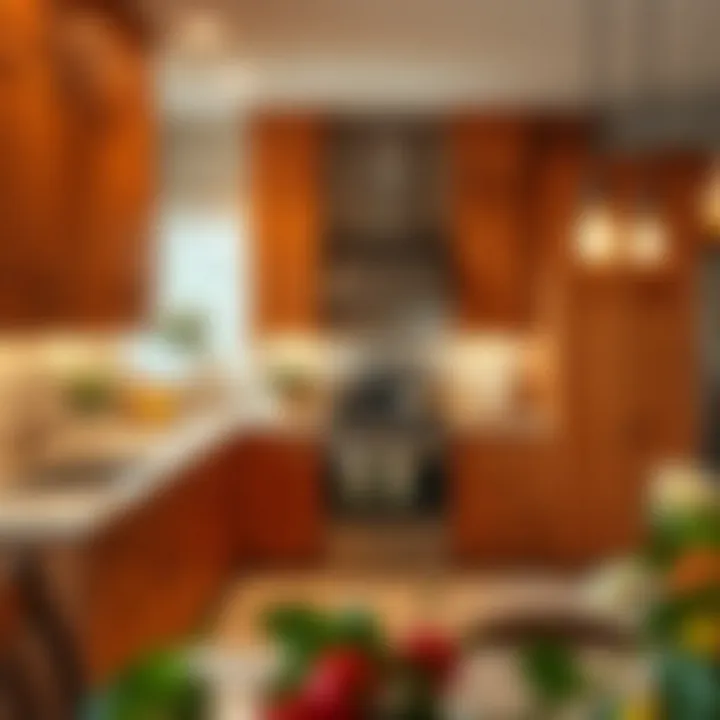
Additionally, if a little extra shine is what you’re after, opting for a semi-gloss or gloss finish can provide a beautiful sheen without burring the beauty of the maple underneath. Another notable choice could be an oil-based finish, which tends to enhance the grain and provide rich depth, although it typically takes longer to cure.
Remember, always prioritize the specific requirements of your kitchen environment when selecting your finishing options. This decision impacts not only the visual appeal of the cabinetry but also the longevity and maintenance needs.
"The right finish for your maple cabinets can mean the difference between a stunning long-lasting kitchen and one that looks dated and dulled in a few short years."
In summary, whether you're finishing your cabinets with stains or paints, or sealing them with a robust clear coat, each choice carries its own weight and importance. Make sure to thoughtfully consider how each option aligns with your style, kitchen function, and the overall vibe of your home.
Practical Benefits of Maple Wall Cabinets
When it comes to kitchen cabinetry, maple wall cabinets stand out not just for their aesthetic appeal but also for a range of practical benefits that cater to the needs of modern homeowners. As more people invest in their homes, understanding the advantages of maple cabinets can help those making choices in design and functionality. Let's delve into some of the key practical benefits that maple wall cabinets provide, focusing on storage capacity and ease of maintenance.
Storage Capacity
One of the most significant advantages of maple wall cabinets is their ample storage capacity. Whether you’re an avid cook or someone who loves keeping a tidy kitchen, efficient storage is paramount. Maple wood's sturdy nature enables manufacturers to create cabinets that can hold substantial weight, allowing for deeper shelves and wider openings. This is especially beneficial for storing large appliances, pantry items, and dishware all within reach.
Moreover, because maple is a hardwood, cabinets constructed from this material are often more durable and resilient over time compared to those made from softer woods. This strong foundation means your cabinets can hold a larger volume without showing wear and tear, keeping your kitchen organized for years to come.
Here are some key features to consider:
- Adjustable Shelves: Many maple cabinets come with adjustable shelving, allowing you to customize the space to fit your specific storage needs.
- Overhead Space Utilization: With wall cabinets reaching to the ceiling, you can maximize the vertical space in your kitchen for storing less frequently used items.
- Built-in Organizers: Features such as pull-out drawers or compartments can transform ordinary cabinets into highly functional storage hubs that keep your kitchen tidy.
Ease of Maintenance
From spills to general wear, maintaining kitchen cabinets can be akin to wandering through a minefield. Maple cabinets offer a relatively low-maintenance option for the busy homeowner. Their smooth finish and consistent texture make them easy to wipe down and keep clean. A simple mixture of mild soap and water is often sufficient for maintaining their appearance without the need for harsh chemicals.
Additionally, maple wood has a natural resistance to moisture, which is a prime consideration in a busy kitchen setting. With proper sealing, these cabinets can withstand high humidity levels and are less likely to warp or swell compared to other wood types.
Some essential maintenance tips include:
- Regular Cleaning: Wipe surfaces with a soft cloth and a gentle cleaner to remove grime and prevent build-up.
- Avoid Excessive Water: While maple is moisture-resistant, it’s wise to avoid prolonged exposure to water, especially around seams and joints.
- Use Furniture Polish: Occasionally applying furniture polish can help enhance the wood’s natural luster and provide a protective layer against scratches.
For further insights on cabinet options and materials, consider visiting Wikipedia or checking out discussions on Reddit about optimizing kitchen spaces.
Integrating Maple Cabinets into Kitchen Design
Integrating maple cabinets into kitchen design goes beyond just installation and placement; it’s about creating a harmonious environment where aesthetics and practicality meet. The warm tones and unique grain patterns of maple wood not only add visual interest but also provide durability and functionality in the kitchen space. Understanding how to coordinate these cabinets within the overall design scheme is crucial for achieving a balance that reflects personal style while accommodating the cooking and entertaining aspects of the home. Here are some key areas to focus on:
- Harmony with Existing Decor: It's essential to assess the current color palette and style of your kitchen before selecting the finish and design of your maple cabinets. Maple’s light, golden hues can blend well with a multitude of styles, from contemporary to rustic, making it a versatile choice. Think of how the warmth of maple adds character to a modern kitchen with minimalist aesthetics or how it harmonizes with farmhouse elements like shiplap.
- Functionality and Flow: The practical side of incorporating maple cabinets also plays a role. The arrangement of wall cabinets can enhance accessibility and flow during meal preparations or gatherings. Optimizing cabinet placement ensures that everyday necessities are within reach while maintaining a clean look.
- Personal Indications: Investing in cabinets is not just about the wood itself; it’s also about expressing individual taste through color, design, and layout.
Color Schemes and Coordination
Choosing the right color scheme for your maple kitchen cabinets can elevate the entire space. Maple naturally comes in various shades from light cream to a rich amber, which can influence the overall mood of the kitchen.
- Complementary Hues: A great color scheme incorporates complementary colors that won't compete with the warmth of maple. Cool colors like whites, grays, or even blues often work well. The contrast can create an inviting atmosphere, enhancing the light tones of maple without overshadowing them.
- Accent Colors: If you desire to introduce a pop of color, consider using accent pieces. Backsplashes or kitchen textiles—like curtains or tableware—in shades of greener or vibrant yellows can provide a lively touch. This can make the space intentionally lively while maintaining a crisp look.
- Testing in Real Light: It’s advisable to view samples of the cabinet colors in different lighting conditions. The tone can change as natural light shifts throughout the day. Therefore, seeing these shades against different wall colors can provide insights before committing to a final design.
"The color palette selected for the kitchen directly affects its functionality and ambiance - a well-thought-out scheme can make a small area feel spacious and cozy at the same time."
Combining with Hardware and Fixtures
The combination of maple cabinets with appropriately chosen hardware and fixtures is vital in bringing everything together in your kitchen.
- Hardware Selection: The choice of knobs, pulls, and hinges can elevate the design. Consider brushed nickel or matte black for a clean, contemporary look, or brass for a touch of vintage charm. Each selection should complement the warm tones of maple without overpowering them.
- Lighting Fixtures: Lighting is another essential aspect. Pendant lights over an island or under-cabinet lighting can create layers of light that enhance the beauty of maple cabinets in the evenings. Opt for fixtures that emphasize the natural qualities of wood without competing with it.
- Supportive Accessories: Lastly, do not forget countertops and sinks. Materials that harmonize with maple, like quartz or granite in neutral hues, can unify the look. It's about creating a cohesive storyline through all elements in your kitchen.
Environmental Impact of Maple Cabinets
Understanding the environmental impact of your kitchen cabinets goes beyond aesthetics and functionality. It invites a crucial conversation about sustainability in home design. When opting for maple kitchen cabinets, homeowners and designers should consider both the sourcing of the wood and its lifecycle, as these aspects significantly influence ecological welfare.
Sustainable Sourcing
Choosing maple wood for your cabinets introduces a vital aspect of sustainable living. Sustainable sourcing isn’t just a marketing term; it reflects a commitment to our forests and ecosystems. Maple trees, particularly in North America, are often harvested in a responsible manner, ensuring that forests remain healthy and thriving. This is paramount in maintaining biodiversity and reducing carbon footprints.
When maple is sourced from forests that adhere to sustainable management practices—like those certified by the Forest Stewardship Council (FSC)—it encourages diligent forestry. These practices mitigate deforestation, promoting the growth of new trees and maintaining the habitats of various wildlife. This, in turn, reinforces the cycle of nature, allowing communities and ecosystems to flourish.
In addition to environmental benefits, opting for sustainably harvested maple cabinets can also enhance your home's value. Buyers increasingly look for eco-friendly designs, creating a dual benefit of style and conscience. The investment thus becomes a statement of both quality and responsibility.
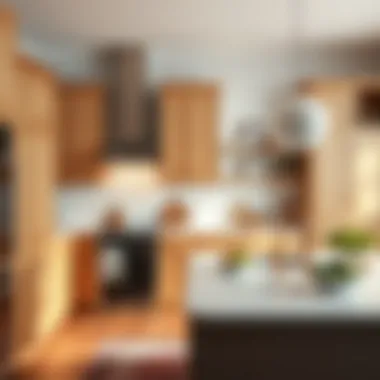
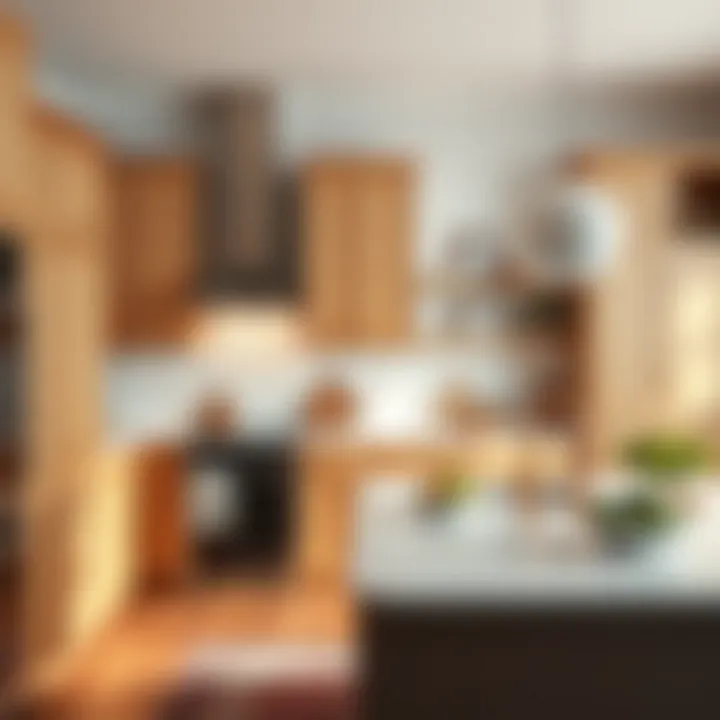
Longevity and Lifecycle
A significant yet often overlooked advantage of maple cabinets is their durability. Maple is renowned for its density and strength, making them resilient against wear and tear in busy kitchen environments. This quality contributes to a longer lifecycle, surpassing both aesthetic expectations and practical needs. A durable cabinet means less need for replacement, which reduces waste significantly over time.
Moreover, the lifecycle of maple cabinets doesn’t end after installation. Their resistance to scratches and dents means they maintain their beauty without requiring frequent refinishing or replacement, minimizing resource consumption in the long run. As such, investing in maple is more than just about the present; it’s a forward-thinking approach toward sustainability.
"When you choose maple cabinets, you're not just opting for exquisite beauty—you're making a decision that echoes through the environment, supporting sustainable forestry and longevity in design."
The lifecycle also sizes down the need for chemical treatments or harsh cleaning supplies. A simple wipe-down with mild soap and water is all it takes to keep them looking sharp. As these cabinets excel in durability, the frequency and intensity of maintenance lessen, translating to a healthier home.
Ending
In summation, the environmental impact of maple cabinets extends from their sustainable sourcing to their impressive longevity. This reinforces the idea that maple kitchen wall cabinets are not only a smart choice for aesthetics but also a nod towards sustainable living and ecological responsibility. For anyone invested in thoughtful design paired with environmental consideration, maple serves as a valuable option.
Maintenance of Maple Kitchen Cabinets
Maintaining maple kitchen cabinets goes hand in hand with owning such a functional piece of furniture. It ensures their longevity, preserves their beauty, and keeps them looking pristine. Maple, known for its durability and strength, can still benefit from a bit of regular TLC. Think of these cabinets as an investment; when taken care of properly, they stand the test of time, much like a well-loved family recipe.
Understanding how to clean and care for these cabinets is as crucial as choosing the right ones for your kitchen design. Proper maintenance can help avoid unnecessary damage and maintain the aesthetic qualities that make maple cabinetry appealing.
Cleaning Methods
Cleaning your maple kitchen cabinets doesn’t need to be a daunting task. In fact, with a few simple methods, you can keep them looking fresh and new. Here are some tried-and-true techniques:
- Mild Soap and Water: Using a soft cloth dampened with a mix of mild dish soap and water can work wonders. It's important to wring out the cloth well to avoid soaking the wood. This method removes grime without the use of harsh chemicals.
- Vinegar Solution: If your cabinets need a bit more oomph, a vinegar and water solution can help. Mix equal parts white vinegar and water, apply it with a soft cloth, and wipe dry immediately. The vinegar acts as a natural disinfectant while preserving the wood’s surface.
- Avoid Abrasives: It can be tempting to scrub hard when you see a stubborn stain, but it’s best to steer clear of abrasive cleaners that could scratch the finish. Gentle wiping will keep the maple unharmed.
- Polishing: To restore some shine, consider using a wood-safe polish occasionally. Just be careful not to overdo it as build-up can occur if applied too frequently.
"Regular cleaning is not just about appearance; it’s about maintaining the integrity of the wood and ensuring it lasts for years."
Preventative Care
Preventative care is like putting up a personal shield for your cabinets. With a few strategic steps, you can significantly extend the life of your maple cabinets and keep their finish beautiful.
- Humidity Control: Wood is sensitive to the environment. Keeping your kitchen humidity level consistent can help prevent warping or cracking. A dehumidifier or humidifier can be handy tools to maintain balance, especially in extreme climates.
- Avoid Direct Sunlight: While maple has a strong aesthetic appeal, direct sunlight can cause fading and discoloration over time. Consider using curtains or shades to protect your cabinets during long sunny days.
- Door Buffers: Installing door buffers or bumpers can help prevent chipping at the edges and maintain the structure of your cabinets. Those little soft pads go a long way in preserving the look and avoiding minor damages.
- Regular Inspections: Taking a good look at your cabinets every few months can help you spot early signs of wear and tear. It’s much easier to tackle a small issue before it turns into a larger problem. Look for things like loose hinges or the beginnings of water damage.
In the end, proactive maintenance and care of your maple kitchen cabinets will not only enhance their beauty but will also ensure they remain a cherished part of your kitchen for years. Investing a little time and effort in cleaning and preventative measures pays off in spades.
Budget Considerations
When contemplating a kitchen remodel, especially with the aim of incorporating maple kitchen wall cabinets, understanding budget considerations is pivotal. A clear financial plan not only helps avoid unwelcome surprises down the line but also ensures that the desired aesthetic and functionality can be achieved without compromising quality. Maple cabinets, given their solid construction and stylistic versatility, often represent a notable investment. However, their long-term benefits make them a wise choice for a range of budgets.
Cost Breakdown of Maple Cabinets
Understanding the cost associated with maple kitchen cabinets is crucial for making an informed decision. Generally speaking, prices can vary depending on several factors such as cabinet size, construction type, finish, and brand. Below is a typical cost breakdown you might expect:
- Material Costs: Maple wood tends to be mid-range in pricing compared to other woods like oak or cherry. On average, cabinet boxes made from maple can range anywhere from $150 to $300 per linear foot.
- Construction Type: Ready-to-assemble (RTA) cabinets are often more budget-friendly, while custom cabinetry which provides a tailored fit can dramatically increase costs, potentially peaking between $500 to $1,000 per linear foot.
- Finishing Options: The type of finish also influences the cost. Staining maple can add between $50 and $150, while painting can be more depending on the complexity of the color and number of coats.
In total, a set of twelve upper cabinets might commonly range from $2,000 to $5,000, factoring in materials, construction, and finish options. Such an investment should always consider quality, because with cabinets, you quite literally get what you pay for.
Value over Time
Investing in maple cabinets can prove to be economically advantageous in the long run. Here are a few considerations that highlight the value those cabinets can bring:
- Longevity: Maple is known for its robustness. Proper maintenance, like regular dusting and occasionally applying a clear coat, can extend the life of your cabinetry significantly, ensuring they outlast cheaper material alternatives.
- Style Resilience: Maple's versatile appearance means it can fit into various kitchen designs, from traditional to modern. An ageless design choice often reduces the need for future renovations.
- Home Value: Quality cabinetry tends to enhance the overall value of your home. Potential buyers typically appreciate the aesthetic and functional appeal of well-maintained maple cabinets, which could lead to higher offers when selling.
"Investing in high-quality maple cabinetry is likely to yield dividends over time, enhancing not only your kitchen's beauty but also your home's resale value."
Closure
In considering maple kitchen wall cabinets, the ultimate takeaway is their unique blend of beauty, durability, and functionality. The cabinets crafted from maple bring a warm, inviting element to the kitchen, acting not just as storage, but as a defining feature of the space. Homeowners and designers alike should ponder the distinct advantages that maple offers. From its impressive strength to its natural aesthetic appeal, maple serves as a strong candidate for anyone serious about creating an efficient and visually stunning kitchen.
Recap of Key Points
To summarize the core aspects we've explored:
- Durability: Maple is renowned for its strength, making it a practical choice for cabinets that endure daily use.
- Aesthetic Qualities: With its rich grain and color variations, maple provides versatility in design, accommodating various styles from traditional to modern.
- Finishing Options: The adaptability of maple to stains and paints enhances its aesthetic potential, allowing for customization that meets individual tastes.
- Maintenance: Keeping maple cabinets pristine is straightforward, requiring minimal effort to maintain their natural beauty over time.
- Environmental Considerations: Sourced sustainably, maple cabinets offer a responsible choice for those conscious about environmental impact.
Each point illustrates why maple cabinets deserve a spot at the forefront of any kitchen design consideration. The nuances of their beauty coupled with their practical benefits position them as a formidable option in cabinetry choices.
Final Thoughts on Maple Cabinets
Reflecting on our exploration, it's evident that maple kitchen cabinets are not just a mere choice but an investment in quality and style. They stand the test of time, both in appearance and function. When executed well, maple cabinets can transform an ordinary kitchen into an extraordinary one. Designers and homeowners should not underestimate the potential these cabinets hold. Whether in a sleek, modern home or a cozy, classic kitchen, maple can find its place beautifully.
Certainly, it’s wise to stick with reputable sources when contemplating a purchase. For more insights into interior design trends and materials, consider exploring resources from Wikipedia, Britannica, and design forums on Reddit.



